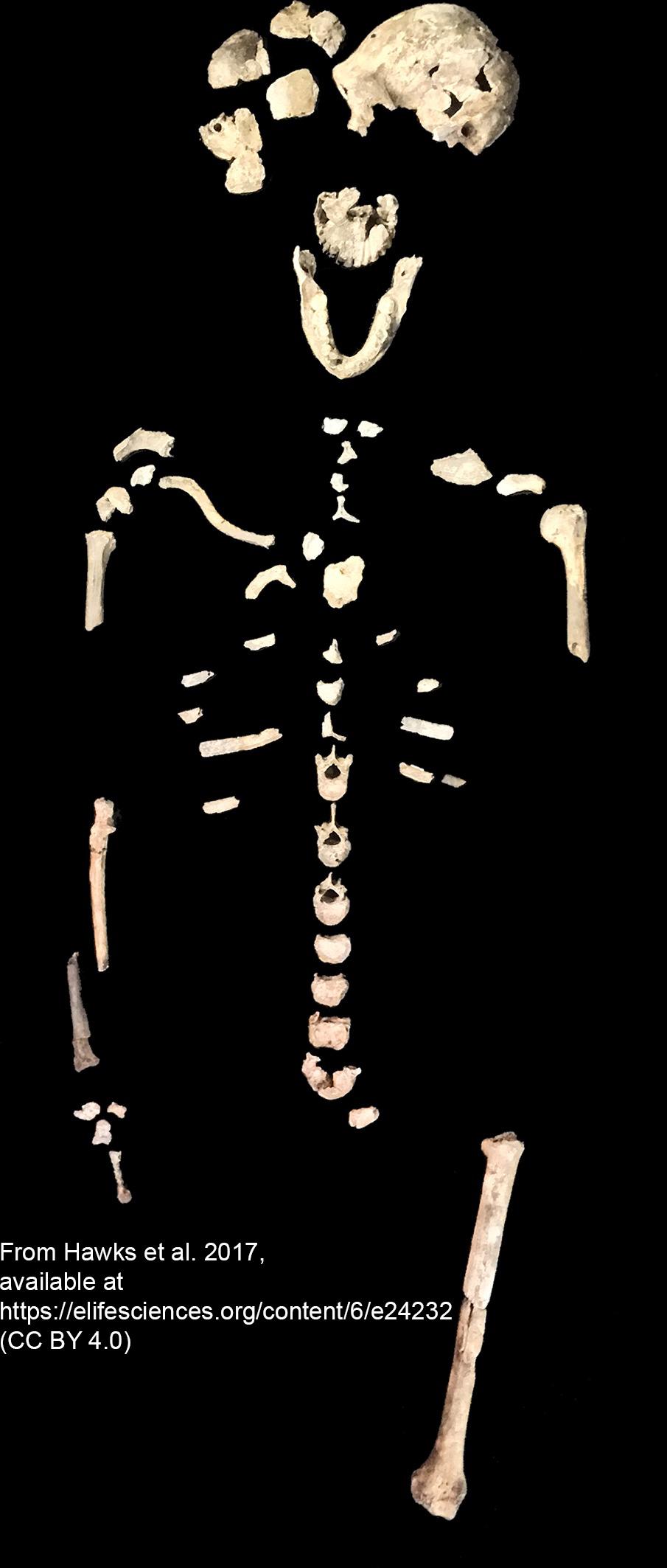©Copyright 2018 GEOSCIENCE RESEARCH INSTITUTE
11060 Campus Street • Loma Linda, California 92350 • 909-558-4548

This blog post complements a piece written for the GRI blog on October 2015, linked here.
Two important papers were published in May 2017, warranting an update on the subject of Homo naledi.

The first publication [1] reports the discovery of hominin remains from a different location in the Rising Star cave system. These include a partial skeleton (with a near complete cranium) (Fig. 1) and remains from at least two other individuals. The morphologic characteristics are “indistinguishable” from the H. naledi sample from the Dinaledi chamber published in 2015. The upper range of cranial capacity, when the latest specimen of H. naledi is included, increases to 610 ml.
The second publication [2] expands upon the initial description of the stratigraphy of the Dinaledi chamber deposits, and presents an estimated age for the H. naledi remains found there. The estimate is based on a variety of methods, with different degrees of reliability, but the authors converge on a period between 236 ka and 335 ka as their best age estimate.
Significance:
The intentional disposal hypothesis
The discovering team has strongly advocated this hypothesis for the accumulation of the H. naledi remains in the Dinaledi chamber, especially in non-academic media outreach. The idea conveyed is some sort of funerary practice, with caching of carcasses in the same specific chamber in different occasions, possibly using torches to light the way to this remote location. However, the new discoveries show that remains of H naledi are not confined to the Dinaledi chamber. Also, the most recent results indicate that fossils found in the Dinaledi chamber are not from multiple levels, but they are all from the same level. This is a significant correction, because in the original paper [3] the H. naledi remains were described as coming from two separate layers. This evidence had been used to imply repeated events of “disposal” of carcasses and to exclude the mass mortality/death trap scenario.
Furthermore, in the original description of the Dinaledi chamber deposits, it was reported that the only macroscopic remains found in the sediments were from H. naledi. The new paper [2] specifies that two long bones (unidentified, but not hominin) are present in the cave deposits and also a baboon tooth has been found. These remains are interpreted as older than the H. naledi fossils. This is also an important correction because it was suggested that only very fine grained sediment could get into the chamber through sedimentary transport, but apparently other macroscopic remains (different from H. naledi fossils) found their way to deposition in the chamber.
The “young” age estimate
The mixture of “archaic” and “modern” characters in H. naledi had sparked some hopes that this form could fill the gap in the poorly documented early stages of the evolution of the genus Homo. This expectation was well exemplified by the PBS-NOVA documentary “Dawn of Humanity,” which ended with the assertion: “the tantalizing gap in the fossil record at the beginning of our genus is being slowly filled in. Finally, there is light at the dawn of humanity.” However, the age estimate places H. naledi more towards the dusk than dawn of humanity. In the words of Schroeder et al. (2017) [4], it represents another example “where species with small brains and H. erectus-like morphology persisted into more recent times, creating a profound disjunction between geological and morphological age.” Therefore, H. naledi complicates the attempts of creating an evolutionary sequence in the hominin fossil record and reinforces the conclusion of a mosaic distribution of characters in fossil forms. Interestingly, hybridization between different types is presented more and more as a possible explanation for this mosaic combinations of characters. Berger et al. (2017) [5], for example, explicitly mention the possibility that “H. naledi resulted from the hybridization of a more human-like population and a late-surviving australopith,” even if they see this as a currently untestable hypothesis.
References
[1] Hawks, J., et al., New fossil remains of Homo naledi from the Lesedi Chamber, South Africa. eLife, 2017. 6: p. e24232.
[2] Dirks, P.H.G.M., et al., The age of Homo naledi and associated sediments in the Rising Star Cave, South Africa. eLife, 2017. 6: p. e24231.
[3] Berger, L.R., et al., Homo naledi, a new species of the genus Homo from the Dinaledi Chamber, South Africa. eLife, 2015. 4.
[4] Schroeder, L., et al., Skull diversity in the Homo lineage and the relative position of Homo naledi. Journal of Human Evolution, 2017. 104: p. 124-135.
[5] Berger, L.R., et al., Homo naledi and Pleistocene hominin evolution in subequatorial Africa. eLife, 2017. 6: p. e24234.
Ronny Nalin, PhD, Geoscience Research Institute